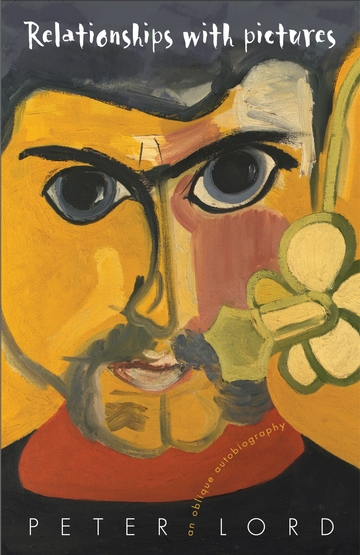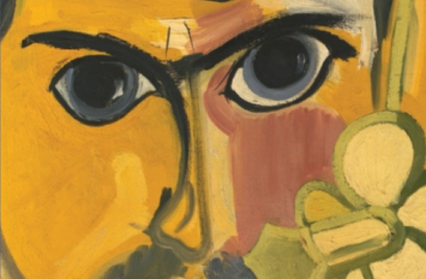Adam Somerset reviews Relationships with Pictures, where Peter Lord explores evolution of his own sense of self through pictures.
‘We grow up in belief and we grow old in belief.’ Peter Lord opens his subtly titled autobiography with these words. ‘Somewhere, in the middle’ he continues, ‘sometimes, facts press upon us. But, in the end, only belief is real.’ Lord’s book is all at once memoir, artistic exploration, the evolution of a unique and crucial critical intelligence for Wales, and the forming of a life’s mission.
Lord’s final destination is far from his beginnings in both location and sensibility. The childhood that begins in 1950 is one where Empire, even in its unfolding, is the prism through which the world is perceived. The streets in home city Exeter bear the names of Ladysmith, Pretoria and Buller. William Lord is a survivor of the Somme and has been in Haifa, Baghdad, Canakkale at the time of the 1922 crisis.
The six-year old Peter remembers an effigy of Nasser standing in for burning on a November 5th night. The names of Makarios and Kenyatta, EOKA and Mau Mau, infiltrate his childhood. His father feels the dissolution of Empire personally. ‘He withdrew into a state of resentment’ writes the son, ‘which seemed to find its outward expression in frustration and anger directed largely at me. I lived in fear of him.’
The young Lord diverges in aptitude and politics utterly from father. At a general election he sees the Prime Minister of the day standing on a wooden box in the drizzle. With a facility for technical drawing and art he just about scrapes an education sufficient to put him on the train from Devon to Reading University. From that point, art – first the making then the assessment – becomes the life.
All good critics are combatants. The passion that moves them throws up its converse, the art, and its promoters, that leave them cold. Lord knows his opponents. By the book’s ninth paragraph a Keeper of Art at the National Museum is fingered, and named, for a false attribution. Lord cites Winifred Coombe Tennant on an earlier holder of the post ‘Poor fellow, so kind, and so utterly boring.’ That first antagonist in Cardiff broadcasts his credo in a radio discussion: ‘an artist is different from other people’ declares this custodian of the nation’s art. He does not believe that ‘the community in England or Wales will ever be interested in art.’

by Peter Lord
312pp, Parthian
Wales makes an early imprint on the course of the life. An unpleasant encounter with the SWP sends him philosophically in the direction of Kropotkin, Ludd and John Seymour. Friendship brings him to Ceredigion’s Mynydd Bach and Trefenter. Another friendship leads him to arrest after a break-in, by way of political protest, into Carmarthen’s Court House. He takes studio space in Aberystwyth’s Barn Centre, along with Cwmni Cyfri Tri, Brith Gof and Colourscape. Photographer Keith Morris is there to guide him to a significant group of portraits in the Methodist Theological College. Of this time Lord simply says ‘my colleagues were a stimulating lot, to say the least.’
Lord locates Wales too in the most Bloomsbury of utterances on art. Clive Bell may intone that ‘Only artists and educated people of extraordinary sensibility and some savages and children feel the significance of form so acutely that they know how things look.’ This particular critic had his extraordinary sensibility honed at Marlborough and Trinity, Cambridge. Bell’s access to these ruminative pastures has been helped, Lord notes, by the family’s extraordinary sensibility to acquire ownership of coal mines in Neath and Merthyr.
Lord’s gripe with Bloomsbury, and its hydra-headed spiritual descendency, is in the act of perception itself. As a sculptor himself, he knows that a work comes from somewhere; it too carries its autobiography, and knowledge of that biography defines perception. He has small patience with ‘the mythology of mainstream art history … let the picture speak for itself.’
Lord’s chapter on Kyffin Williams’ portrait of Jack Jones starts with the artist being told that his depiction is ridiculous. Lord has a lengthy quotation from Jones, which is one of the best testimonies ever of being a sitter. It is testament too that Williams got his subject absolutely right.
This focus on a painting’s story may on occasion tip the balance against appreciation of a work’s formal qualities. The view by Mervyn Levy of Lowry is shared with the curators of the current Tate show. Both fail to convince this viewer, notwithstanding the fine ‘Six Bells, Abertillery’ in Cardiff’s national collection. Lord can on occasion be modest about the art that has consumed his life’s interest. Many of the drawings that the book contains are superb. One, by Maurice Sochachewsky, is literally drawn on the back of an envelope. It makes no difference to the draughtsmanship of Archie Rhys Griffiths whether he is at a Welsh pithead or on a Venetian quayside. Evan Walters’ ‘Dominoes’, of 1920 in the Glynn Vivian, is by any standard a stunning piece of work in form and colour.
In the way of both good criticism and biography Relationships with Pictures roams richly across culture wider than painting. Photographer Bill Brandt and film-maker Cavalcanti are both visitors to 1930’s industrial Wales. Lord’s feelings for football are rooted in a ‘combination of beauty and tribalism which seems paradoxical to those that do not experience it.’
Parthian has employed as editor Jon Gower, a presence now in Welsh letters of near-Updikean ubiquity. Sixteen pages of illustrations, oils, drawings and photographs precede the text. They include a battered print of a troop procession through 1920’s Baghdad, a deep-toned portrait-photo by Marian Delyth, a Mervyn Levy drawing, a wooden church ceiling in Conwy. All are rendered with a depth and fidelity to the original that are the hallmark of the Gomer press.
The literary awards for Wales for 2013 are now a short time away. Peter Lord’s Relationships with Pictures must be an early contender for the 2014 short-list.
Adam Somerset is an essayist and a regular contributor to Wales Arts Review.











